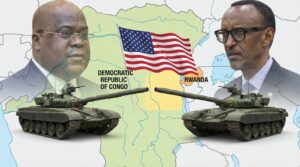- Africa’s Green Economy Summit 2026 readies pipeline of investment-ready green ventures
- East Africa banks on youth-led innovation to transform food systems sector
- The Washington Accords and Rwanda DRC Peace Deal
- Binance Junior, a crypto savings account targeting children and teens debuts in Africa
- African Union Agenda 2063 and the Conflicts Threatening “The Africa We Want”
- New HIV prevention drug is out — can ravaged African nations afford to miss it?
- From banking to supply chains, here’s how blockchain is powering lives across Africa
- Modern railways system sparks fresh drive in Tanzania’s economic ambitions
Author: Laurence Sithole
I am a financial services professional with a strong background in diverse areas of banking. My skill set includes among others International Banking, Trade Finance, Commercial Lending, Customer Service, Finance, Banking, Corporate Finance, and Investment Banking. Africa is my home and I am passionate about its development,
In a previous article, it was established from research that private investors globally have at least US$500 billion in funds under management which they desire to deploy in the development of infrastructure projects across Africa. Africa being the continent that needs this most is ironically the continent that spends the least on the development of its infrastructure. The potential and scope for funding African infrastructure is enormous; however such potential is hamstrung by the state and management of public finances and the debt levels of African governments. Statistics show that less than 10% of infrastructure projects in Africa reach completion…
A lot has been written about the case for investing in Africa. Many journalists and economists have eulogized about the merits of investing in Africa going as far as to describe it as the final frontier. Africa is indeed the so-called final frontier and it is that for very good reason. It has the largest share of any natural resources on the planet that are still untapped for the most part. It is not an exaggeration to describe the continent as a Utopian Eldorado as far as investment is concerned. It is home to the youngest population demographic who will…
Special Drawing Rights (SDRs) are a reserve asset created by the International Monetary Fund (IMF) to supplement its member countries’ reserves.
According to the IMF’s website, a total equal to US$943 billion in SDRs has been allocated to date from the time they were created in 1969. This figure is inclusive of the SDR456 billion approved on the 2nd of August 2021. This most recent allocation was made necessary by the need to help countries around the world to cope with the effects of the COVID-19 pandemic. The value of the SDR is based on a basket of five currencies which include: the US dollar, the euro, the Chinese renminbi, the Japanese yen, and the British pound.
The Reserve Bank of Zimbabwe (RBZ) prefaced its policy review by stating that inflationary pressures have dissipated which it called conducive and supportive of its expected economic growth rate of 7.8 per cent in 2021.
The policy review was characterized by optimism on the part of the monetary authorities as it painted a rosy economic outlook. The tone of the document was very upbeat with the RBZ expecting global economic recovery from the adverse effects of the coronavirus pandemic because of the stimulus packages whose effects it is expected will trickle down to emerging economies and special drawing rights (SDR) allocations adding up to US$650 billion.
Not to be mistaken the adverse impact of the times have been felt at Richemont with sales for the half-year ending 30 September 2020 decreasing significantly by 26 per cent to €5.48 billion against the previous year. This decline in sales resulted in a fall in operating profits of 61 per cent from €1.165 billion to €452 million.
Notwithstanding this slowdown in profits, the company was able to deliver a 78 per cent increase in sales from their China market which has now been overtaken by the Americas as the company’s largest market.
Numerous advantages and benefits have been proffered to explain the motives individuals have for moving their assets offshore and investing in jurisdictions other than their home countries. Standard Bank reckons that offshore investment aids in capitalizing on circumstances outside the country providing a buffer against our markets, our inflation spikes and exchange rate fluctuations.
Essentially, offshore investment serves as a hedge against the volatility and harsh economic fundamentals in the local economy. Zimbabwe as a case in point has suffered from perennial poor economic performance for the greater part of the last two decades. The economic phase that characterized this period included compulsory expropriation of productive farmland, the expropriation of hard currency funds that were never returned, of individuals and organizations by the government to fund its operations, hyperinflation and a generally depressed economy.
The banks themselves have little confidence in each other which is demonstrated by the absence of a real interbank lending market.
Perhaps most striking is the high degree of regulatory risk. Regulatory risk is one where a change in laws and regulations will materially impact a security, business, sector, or market. A change in laws or regulations made by the government or a regulatory body can increase the costs of operating a business, reduce the attractiveness of an investment, or change the competitive landscape in each business sector. In extreme cases, such changes can destroy a company’s business model.
Since then the company has pursued a highly aggressive growth strategy constituting of both organic and acquisitive growth. Sibanye in a very short space of time acquired the Cooke operations from Gold One International in 2013 and the Burnstone project from Wits Gold the following year. The aim of this aggressive growth strategy was to produce more sustainable gold operations.
The story of growth did not stop there.
Soon the company set its sights on the platinum sector and began to snap up various interests and operations in that space. In 2016 Sibanye acquired the Aquarius Platinum’s Rustenburg operations namely Kroondal mine as well as the Platinum Mile treatment facility in South Africa and in Zimbabwe it took over the Mimosa joint venture with Impala Platinum. Later that year the company also bought the Rustenburg operations of Anglo Platinum.
Anglo American is a leading global mining company, with a world-class portfolio of mining and processing operations and undeveloped resources, with more than 95,000 people working for it around the world, in 15 countries. This company on the 29th of July announced its intention to disburse an additional US$2 billion to its shareholders through what it described as an on-market irrevocable and non-discretionary share buyback programme of $1 billion together with a special dividend of $0.80 per ordinary share, equal to $1 billion. All in all, the company intends to return at least US$4 billion in cash to its shareholders when what the company describes as its base dividend of US$4.1 billion is considered.
Anglo American will repurchase up to 204.3 million shares in terms of the buy-back programme that started August 12 and ending no later than 14 February 2022. The US$2.1 billion ordinary dividends is being paid out of an interim attributable profit of $5.2bn. Compared to $471m in interim profit in 2020, that is a staggering year-on-year improvement of just over 1000%.
The reasons for the current position are both economic and political. The intent of this article is to explore the economic side of the country’s decline with the view to put forward new areas of economic significance that can give rise to the recovery of the country’s fortunes.
These new areas if adopted and implemented will most certainly result in economic green shoots and with time they will transform into major industries anchoring the economy on the same scale and extent that mining and agriculture did in the former years.
The political side of the equation of Zimbabwe’s economic decline has been written about extensively and it is beyond the scope of this article. However, it must be noted and borne in mind that it is immensely difficult to separate politics from economics as these two concepts enjoy a very strong symbiotic relationship.




